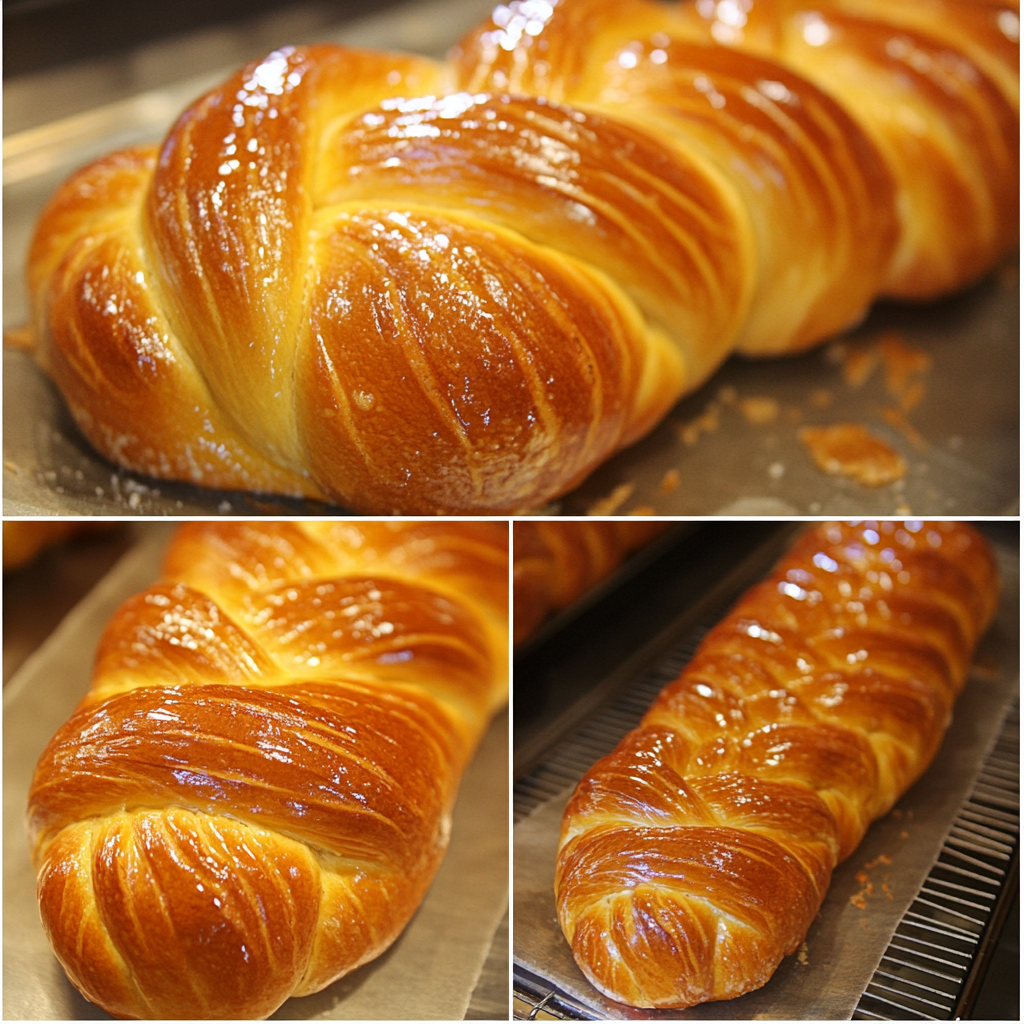There’s something truly magical about pulling a freshly baked Braided Brioche from your oven. That moment when the kitchen fills with the sweet, buttery aroma that seems to wrap around you like a warm hug? Pure bliss! Hi there, it’s Alexandre from foodytasty.com, and today I’m sharing one of my absolute favorite bread recipes that looks impressive but is actually totally doable, even on your busiest days.
As a busy parent myself, I understand the challenge of wanting to create something special while juggling a million other responsibilities. That’s exactly why this Braided Brioche has become a staple in my home. It’s that perfect combination of “looks like I spent all day on it” and “actually fit it in between school drop-offs and work calls.”
Why You’ll Love This Braided Brioche
If you’ve never tried making brioche before, you might think it’s one of those fancy French breads that requires professional baking skills and equipment. Let me stop you right there! This Braided Brioche recipe is surprisingly approachable.
What makes this bread so special is its incredible versatility. It’s sweet enough to enjoy with your morning coffee but not so sweet that it can’t complement a savory dinner. The texture is what dreams are made of – a pillowy-soft interior with a golden, slightly crisp exterior that simply melts in your mouth.
And can we talk about that braided design? Not only does it look absolutely gorgeous on your table (hello, instant Instagram-worthy creation!), but the braiding actually creates these wonderful little nooks and crannies that develop the most amazing texture when baked.
The Magic Behind Braided Brioche
Traditional brioche is classified as an “enriched dough,” which basically means it’s a dough that’s been enhanced with butter, eggs, and milk. These ingredients create that signature rich flavor and tender crumb that makes brioche so irresistible.
The beauty of this particular recipe is that it walks the perfect line between authentic technique and practical home cooking. We’re keeping all the elements that make brioche special while simplifying the process so you can actually fit it into your real life.
Ingredients You’ll Need
For this buttery bread masterpiece, you’ll need:
- 4 cups (500g) all-purpose flour
- 1/4 cup (50g) granulated sugar
- 1 packet (7g) instant yeast
- 1/2 teaspoon salt
- 1/2 cup (120ml) warm milk
- 4 large eggs
- 1/2 cup (115g) unsalted butter, softened
- 1 tablespoon milk (for the wash)
Optional Add-Ins (For When You’re Feeling Extra)
- 1/2 cup raisins or dried cranberries
- 1/4 cup chocolate chips
- 1 teaspoon vanilla extract
- 1 teaspoon orange zest
Making Your Braided Brioche: Step-by-Step
Don’t let the fancy name intimidate you! This sweet bread comes together more easily than you might think. Let’s break it down into manageable steps:
Step 1: Prepare the Dough
- In a large mixing bowl, whisk together the flour, sugar, instant yeast, and salt. This even distribution ensures your brioche will have consistent flavor throughout.
- Create a well in the center of your dry ingredients and pour in the warm milk. The milk should be warm but not hot – think baby bath water temperature. Too hot and you’ll kill the yeast, too cool and it won’t activate properly.
- Crack in the eggs and mix until a shaggy dough forms. Don’t worry if it looks a bit messy at this stage – that’s normal!
- Now for the magic ingredient: butter! Gradually add the softened butter, a few pieces at a time, while mixing. This is where your brioche gets its signature buttery flavor and tender texture.
- Transfer the dough to a lightly floured surface and knead for 10-15 minutes. Fair warning: this dough will be sticky at first, and you might be tempted to add more flour. Resist that urge! A slightly sticky dough means a softer brioche. If you have a stand mixer with a dough hook, you can definitely use it here to save your arms a workout.
Alexandre’s Tip: The dough will transform as you knead it, becoming smoother and more elastic. You’ll know it’s ready when it stretches without tearing immediately – what bakers call the “windowpane test.”
Step 2: The First Rise
- Place your beautiful dough in a lightly greased bowl and cover it with a clean kitchen towel or plastic wrap.
- Let it rise in a warm, draft-free spot for 1-2 hours, or until it doubles in size. If your kitchen is chilly (like mine often is!), try placing the bowl near your preheating oven or on top of the refrigerator – both spots tend to be slightly warmer.
- To check if it’s ready, gently press the dough with your finger. If the indentation remains, you’re good to go to the next step!
Alexandre’s Secret: For an even more flavorful brioche, you can refrigerate the dough overnight for its first rise. This slow fermentation develops amazing flavor, plus it makes the dough easier to handle when braiding. It’s also perfect for busy schedules – prep the dough in the evening, then shape and bake the next day!
Step 3: Shape Your Braided Brioche
This is where the magic happens – transforming your dough into that beautiful braided creation:
- Gently punch down the risen dough to release any air bubbles. This isn’t the time to take out your frustrations – just a gentle press will do!
- Divide the dough into three equal portions. I like to use a kitchen scale for this to ensure they’re even, but eyeballing works too.
- Roll each portion into a long, even strand, about 12-14 inches in length. Think of making play-dough snakes – same concept, tastier result!
- Arrange the three strands side by side and pinch them together at one end. Now, braid them just like you would braid hair – left strand over middle, then right strand over middle, and repeat until you reach the end. Pinch the other end to seal the braid.
- Transfer your braided beauty to a greased loaf pan or baking sheet. Cover it lightly and let it rise again for 30-45 minutes, until it looks puffy and has expanded noticeably.
Alexandre’s Tip: If you’re feeling creative, try a four-strand braid for an even more impressive look, or shape the braid into a circle for a festive holiday wreath presentation!
Step 4: Bake to Golden Perfection
- While your dough is on its second rise, preheat your oven to 350°F (175°C).
- Gently brush the top of your braided dough with milk. This simple step creates that gorgeous golden, shiny crust that makes brioche so irresistible.
- Bake for 25-30 minutes, until the top is a deep golden brown and the bread sounds hollow when tapped gently.
- Here’s a pro move: if you notice the top browning too quickly, tent it with aluminum foil halfway through baking. This prevents the outside from burning while giving the inside time to cook completely.
- Once baked, let your brioche cool in the pan for about 10 minutes before transferring it to a wire rack to cool completely.
Braided Brioche: Serving Suggestions & Creative Ways to Enjoy
Now that your beautiful braided brioche has filled your kitchen with its intoxicating aroma and is cooling on the rack, let’s talk about all the delicious ways you can enjoy this buttery bread masterpiece!
Serving Your Homemade Braided Brioche
One of the greatest joys of making brioche is its incredible versatility. Here are some of my favorite ways to serve this soft bread:
For Breakfast or Brunch
There’s something so special about starting your day with homemade brioche. Slice it thick, toast it lightly until the edges are just golden, and the centers remain soft and pillowy. Then top with:
- A generous smear of salted butter that melts into all those beautiful nooks and crannies
- Your favorite jam or preserves (strawberry and apricot are personal favorites)
- A drizzle of honey or maple syrup
- A dollop of Nutella for those chocolate-loving mornings
- Cream cheese and fresh berries for a lighter option
For Lunch
Yes, this sweet bread works beautifully for lunch too!
- Split it horizontally and create a seriously upgraded sandwich with prosciutto, sliced pears, and a touch of brie
- Use it for the most incredible grilled cheese you’ve ever experienced
- Cut into cubes, toast lightly, and top your favorite soup as elegant croutons
For Dessert
This is where brioche really shows off its transformation abilities:
- Make the world’s most decadent French toast casserole by soaking thick slices overnight in a vanilla-scented custard
- Create a brioche bread pudding with chocolate chips and a whisper of cinnamon
- Cube and layer with pastry cream and fresh berries for a quick trifle
Tips for Perfect Braided Brioche Every Time
After making this recipe countless times (my family practically demands it now), I’ve picked up a few tricks along the way:
The Butter Matters
Spring for good quality, unsalted butter if you can. The butter is such a prominent flavor here that using the good stuff really makes a difference. And always make sure it’s properly softened—not melted, not cold and firm, but soft enough that your finger leaves an indent when you press it.
Temperature Is Everything
Brioche dough can be a bit temperamental when it comes to temperature. Too warm, and it gets sticky and unmanageable. Too cold, and it won’t rise properly. If you find your kitchen is particularly warm, don’t hesitate to pop the dough in the refrigerator for 15-20 minutes before braiding.
The Window Pane Test
Not sure if you’ve kneaded enough? Try the window pane test: take a small piece of dough and gently stretch it between your fingers. If you can stretch it thin enough to see light through it without tearing, your gluten is well-developed and you’re good to go!
Don’t Rush the Rise
On busy days, it’s tempting to hurry the rising process. I’ve been there! But giving the dough adequate time to rise is crucial for that perfect texture. If you need to fit baking into a busy schedule, use the overnight refrigeration method I mentioned earlier.
Alexandre’s Confession: Once, I was so impatient to try my brioche that I sliced into it while it was still warm from the oven. The result? A slightly squished, gummy slice. Learn from my mistake and let it cool at least 30 minutes before cutting in!
Storing Your Buttery Bread Creation
Homemade brioche doesn’t contain preservatives, which means it won’t last as long as store-bought bread—but trust me, that won’t be a problem because it disappears quickly!
- Room Temperature: Store in an airtight container for up to 2 days. A bread box works wonderfully if you have one.
- Freezer: This brioche freezes beautifully! Slice before freezing, wrap well, and store for up to a month. Toast frozen slices directly from the freezer for a quick treat.
- Reviving Stale Brioche: If your brioche has gotten a bit stale, don’t toss it! That’s the perfect time to transform it into French toast or bread pudding.
The Story Behind My Braided Brioche
I still remember the first time I attempted to make brioche. My grandmother had passed her recipe down to me, written on a yellowed index card with butter stains in the corners. I was so nervous about getting it right that I must have read the recipe twenty times before starting.
The dough was stickier than I expected, and my braid looked more like a sad, lumpy caterpillar than the beautiful creation I’d envisioned. But when that aroma started wafting through the house and I pulled that golden loaf from the oven? Pure magic.
Now, years later, my kids come running to the kitchen whenever they smell brioche baking. My daughter has become my official “braiding assistant,” and even my teenager, who’s currently in a phase where anything mom does is decidedly uncool, makes an exception for brioche day.
That’s the true beauty of this recipe – it’s not just about creating an impressive bread; it’s about creating moments and memories in your kitchen.
Frequently Asked Questions About Braided Brioche
Can I make brioche dough in advance?
Absolutely! In fact, brioche dough benefits from an overnight rest in the refrigerator. The slow, cold fermentation develops more flavor, and the chilled dough is easier to braid. Just let it come to room temperature for about 30 minutes before shaping.
My brioche seems too dense. What went wrong?
Dense brioche usually means one of three things: your yeast wasn’t active (check the expiration date!), the dough didn’t rise long enough, or too much flour was added during kneading. Remember that brioche dough should be slightly sticky – resist the urge to add too much extra flour.
Can I use this buttery bread dough for other shapes besides a braid?
Definitely! This same sweet bread dough works beautifully for individual brioche à tête (those cute little brioche with the topknot), dinner rolls, or even shaped into a sandwich loaf. The baking time may vary slightly depending on the size of your shapes.
More Than Just Bread: Why Braided Brioche Matters
There’s something deeply satisfying about creating a loaf of braided brioche from scratch. In our busy world of instant everything, taking the time to mix, knead, shape, and wait for dough to rise is almost meditative. It connects us to generations of bakers before us who understood the simple pleasure of creating something beautiful and delicious with their hands.
When you serve homemade brioche to your family or friends, you’re offering more than just bread – you’re sharing love, care, and a moment to slow down and savor life’s simple pleasures. And in my book, that’s what good food is all about.
So whether you’re a seasoned baker or trying brioche for the first time, I hope this braided brioche recipe brings as much joy to your kitchen as it has to mine. Remember, don’t stress if your braid isn’t perfect – those “character marks” just prove it’s homemade with love!
Happy baking!
- Alexandre
Explore More Delicious Recipes
If you enjoyed this Braided Brioche recipe, you might also love these other treats from our kitchen:
- Cinnamon Roll Bread – All the flavor of cinnamon rolls in an easy-to-make bread!
- Easy No-Knead Artisan Bread – Perfect for busy days when you want fresh bread with minimal effort.
- Homemade Soft Pretzels – A fun baking project to try with kids!
Learn More About Bread Baking
For more information about the science behind great bread, check out these helpful resources:
- King Arthur Flour’s Guide to Yeast Bread – An excellent resource for understanding the fundamentals of yeast bread baking.
- The Kitchn’s Baking School – Wonderful tutorials for bakers of all levels.
- The Bread Baker’s Apprentice by Peter Reinhart – My favorite bread baking book that transformed my understanding of fermentation.



